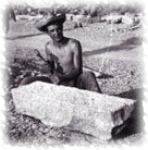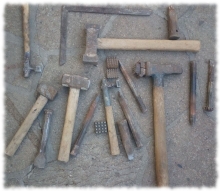Up until forty years ago, arriving near a quarry, the tinkling of hammers on steel tools and the rumbling of some compressed air pistol that prepared the cognare to cut stones could be heard as the predominant sound. Today we hear the loud noise of diamond saws and air bushes. The quarries have turned into modern laboratories that produce perfect works and the stonemason can work only thanks to the connoisseur or realizing works that the machines cannot do as opus incertum, paving with blunt stones, works in the face, restorations on rustic to the originals. In the period in which the noise of the steel of the ponciotti and giandini could still be heard, in other words the "Irons" which were used to cut and trim the stone, were often obtained from the steel of the axles of the trucks then forged and beaten and finally tempered to meet the requirements of a stonemason. The tips for trimming the stone are still today octagonal steel rods of 17-18 mm in diameter, cut into pieces then forged, beaten and tempered, adapting the steel to the hardness of the stone. The chisels were of the same kind as the points but prepared at the end of the forging with a cut. Today the few remaining stonemasons use tempered spikes like in the past or use the mason hexagonal ones or the harder ones with Widia spikes; the true stonemasons improvise smiths forging, beating and tempering their tools according to the stone to be worked. The giandini, chisels and bushmen have usually widia plates. The hammers used are of a bundle of about 1 kg for common jobs, smaller but with the same shape to make high-low relief, a 5 kg bat to beat the ponciotti that cut the stones. The handles of hammers as per tradition, are usually made with Bagolaro wood or stony tree (Celtis Australis), given its qualities of hardness and elasticity. The branches are cut and left to rest for a couple of years and then processed according to the desired handle.


